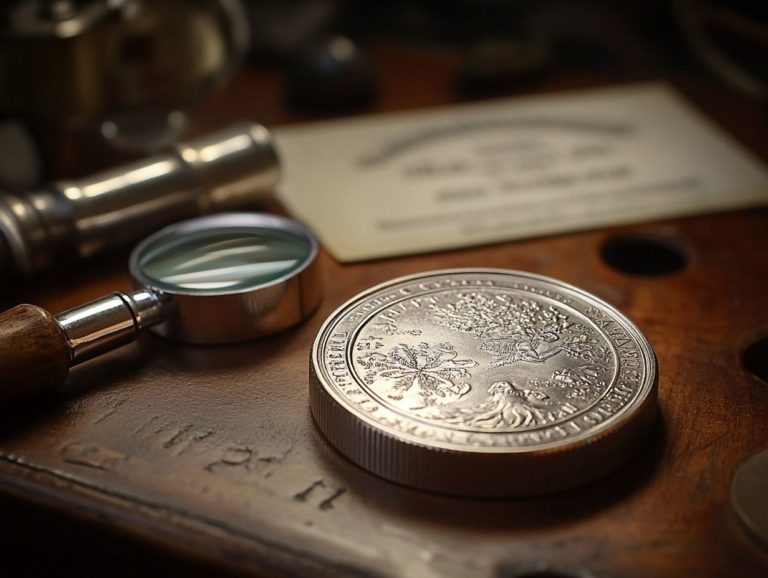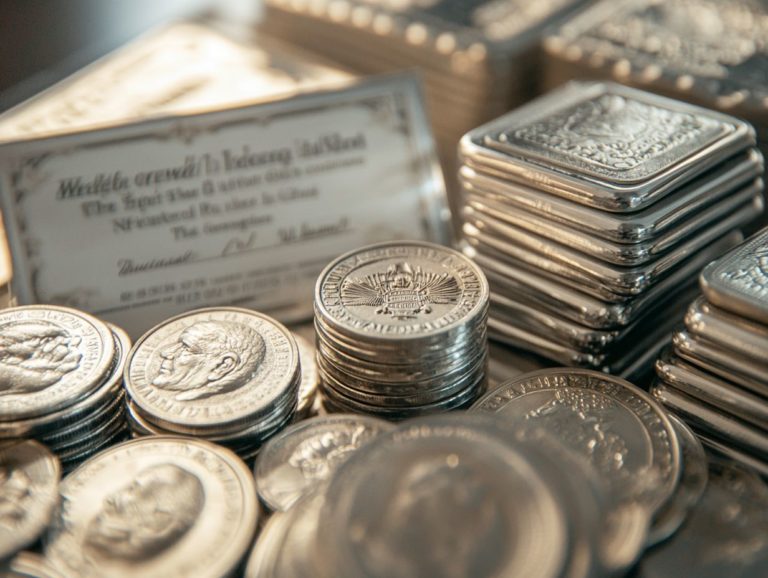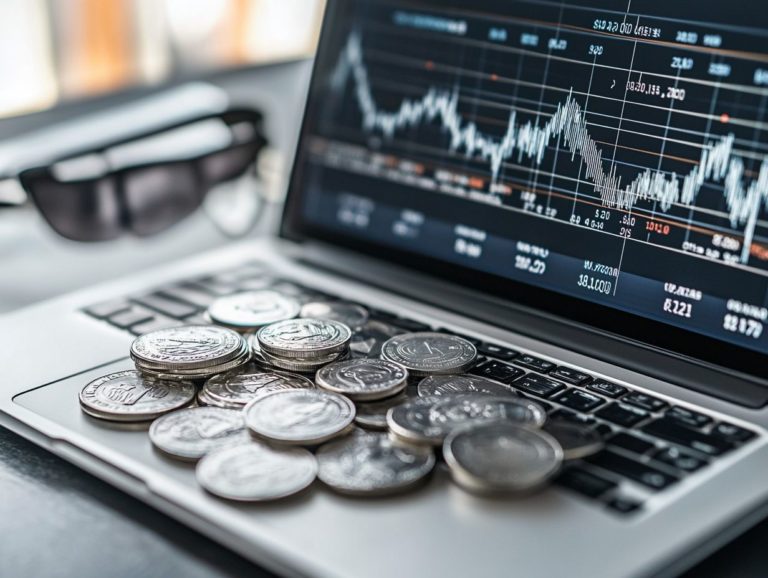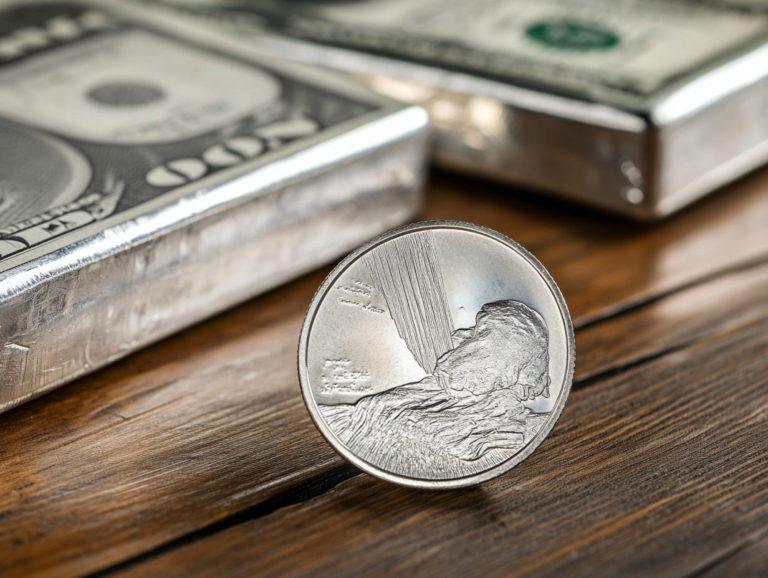How to Educate Yourself About Silver Investing
Investing in silver can elevate your financial strategy, offering not only a way to spread your investments across different assets but also the potential for growth.
This article explores the intricacies of the silver market. It highlights key factors that influence silver prices and equips you with tools to analyze market trends effectively.
You will discover various types of silver investments, from physical bullion to paper assets, providing you with a comprehensive view of your options.
As you navigate through the content, you will learn how to craft a tailored investment plan and access valuable resources to keep you informed.
Dive in and discover why silver could be the ideal addition to your portfolio.
Contents
Key Takeaways:

- Consider the factors that affect silver prices and learn to analyze trends before investing.
- Understand the difference between physical and paper silver investments, and explore other forms of silver investments.
- Develop an investment plan by setting goals, assessing your risk tolerance, and diversifying your portfolio.
Why Invest in Silver?
Investing in silver has become increasingly popular due to its intrinsic value as a precious metal. It provides a unique opportunity for diversifying your financial portfolio.
Silver isn’t just a store of value; it also protects your money from losing value over time, making it appealing for anyone navigating today’s economic landscape. The market price of silver is influenced by various factors, including demand and supply dynamics, which can significantly shape your investment strategy.
Historically, silver has performed well during economic downturns, often retaining its value when other assets stumble. This reliability acts as a safety net, especially amid market volatility.
Compared to gold, silver is generally more affordable and accessible, allowing for greater liquidity and cash flow opportunities. Adding silver to your investment portfolio helps you create a balanced asset mix that reduces risks while boosting your financial success.
Additionally, the metal’s industrial applications ensure a steady demand, further cementing its status as a sound investment choice.
Understanding the Silver Market
Understanding the silver market is essential for investors aiming to make informed decisions. The interplay between silver prices and market trends is shaped by economic conditions and investor sentiment.
By analyzing historical data alongside current trends, you can uncover valuable insights into how the market operates and identify the factors driving fluctuations in silver prices.
Factors Affecting Silver Prices
Many factors influence silver prices, including the dynamics of supply and demand, investor sentiment, and decisions made by the Federal Reserve. Understanding these elements is crucial for navigating the complexities of the silver market.
Studying historical trends and ongoing market shifts such as changes in industrial demand and geopolitical tensions can provide valuable insights.
The significance of mining stocks is also important; fluctuations in production can impact market prices. Coupling this with economic reports detailing unemployment rates, inflation, and GDP growth helps create a broader picture of silver s role in the financial landscape.
Furthermore, the strategies employed by long-term investors and speculators can influence market sentiment, creating a ripple effect that impacts demand and shapes the trajectory of silver prices.
How to Analyze Silver Trends
To effectively analyze silver trends, focus on various analytical methods, including both technical and fundamental analysis. This approach enables you to gauge market conditions and make informed investment decisions.
Understanding the nuances of these analytical techniques will help you formulate a robust investment strategy that aligns with your financial goals. By closely monitoring market trends, you can seize opportunities while mitigating the risks associated with silver investments.
One of the most accessible tools for this analysis is charting software, allowing you to plot historical prices and identify patterns over time. Utilizing indicators such as moving averages and the Relative Strength Index (RSI) can provide you with invaluable insights into potential price movements.
Examining economic indicators like inflation rates and industrial demand will further illuminate the broader market context. If you re considering diversification, ETFs and silver futures offer compelling investment vehicles that give you exposure to silver prices without the need for physical ownership.
Resources like financial news websites and investment platforms enhance your understanding of market dynamics. They help you make more informed decisions.
Types of Silver Investments

You have a range of silver investment options at your fingertips, each designed to align with various investment goals and risk appetites.
You can opt for physical silver, like bullion coins or bars, or delve into paper silver, which encompasses financial instruments such as ETFs and silver futures.
Understanding the pros and cons of each type is crucial for crafting a diversified investment strategy that fits your unique objectives and financial landscape.
Physical Silver vs. Paper Silver
Physical silver and paper silver investments come with unique advantages and disadvantages, making them suitable for different types of investors. Consider physical silver, such as bullion coins and bars, which offers a tangible asset that acts as a hedge against inflation.
Meanwhile, paper silver think ETFs and silver futures provides greater liquidity and ease of trading. Understanding these nuances is essential for shaping your investment strategy.
Regarding storage and security, physical silver demands safe storage solutions, which can incur additional costs like vault fees or insurance. In contrast, paper silver investments free you from the hassle of physical storage, granting convenient access and management through online platforms.
However, while paper silver can boost your cash flow with more liquid trading opportunities, it introduces risks that physical assets do not carry. By weighing these factors, you can better navigate your financial landscape and optimize your asset allocation.
Other Forms of Silver Investments
In addition to traditional physical and paper silver investments, you’ll discover many other exciting silver investment options that can align seamlessly with your financial goals. Silver ETFs, mining stocks, and mutual funds offer diverse avenues to gain exposure to the silver market.
Each choice boasts its own risk profile and potential returns, so make sure to carefully evaluate your options to maximize your financial potential! For example, the Aberdeen Standard Physical Silver Shares ETF and the ETFMG Prime Junior Silver Miners ETF allow you to harness the performance of silver while enjoying the added advantages of liquidity and streamlined transaction processes.
Silver mining stocks often move in lockstep with silver prices, meaning their performance can closely mirror market fluctuations. Additionally, mutual funds centered on silver or precious metals provide a way to mitigate risk through diversification, spreading your investments across various assets.
By incorporating these vehicles into your portfolio, you can enhance your overall investment strategy and strive for more stable returns, even amidst shifting market conditions.
Developing an Investment Plan
Crafting a comprehensive investment plan is essential for realizing your financial aspirations while managing the risks tied to silver investments.
A structured strategy should encompass your risk tolerance, current market conditions, and the need for diversification. This ensures your portfolio remains robust amid market fluctuations.
By establishing clear objectives, you ll navigate the silver market with confidence and clarity, guiding your decision-making every step of the way.
Setting Goals and Risk Tolerance
Setting clear investment goals and knowing how much risk you can handle are vital steps in crafting an effective investment strategy.
Your objectives might include wealth preservation, capital appreciation, and hedging against inflation. Your risk tolerance will guide you toward the types of silver investments that best align with your financial aims.
Consulting with a financial advisor can provide invaluable insights for these important decisions.
If you identify as a conservative investor focused on wealth preservation, you might opt for physical silver bullion or coins. These typically hold their value even in volatile markets.
Conversely, if you see yourself as more aggressive and are seeking capital appreciation, consider exploring silver mining stocks or exchange-traded funds (ETFs). ETFs are funds that track the performance of silver in the stock market.
Each approach aligns differently with various risk tolerances, highlighting the need for personalized investment strategies.
By understanding your unique profile, you can make informed choices that cater to your financial goals while also matching your comfort level in navigating risks.
Diversifying Your Portfolio

Diversifying your portfolio is crucial for minimizing risks and optimizing potential returns in silver investing.
Incorporating a mix of assets such as physical silver, silver ETFs, and mining stocks allows you to create a balanced portfolio. This enhances cash flow and helps resist market volatility.
Effective diversification strategies empower you to leverage silver’s unique characteristics while mitigating potential downturns.
It’s important to consider asset allocation based on current economic conditions since different markets can influence silver’s performance.
By strategically spreading your investments across various silver forms and different sectors, such as technology and renewable energy, you ll be better positioned to manage risk.
Incorporating sector exposure helps you identify growth opportunities or hedge against inflation, factors that can significantly impact your overall investment strategy.
Adjusting asset percentages in response to market fluctuations will also bolster your long-term returns, creating a well-rounded investment approach.
Educating Yourself About Silver
Educating yourself about silver investing is an essential step in making informed financial decisions.
By grasping the intricacies of the silver market its dynamics, trends, and various investment options you position yourself to navigate it confidently.
Utilizing trustworthy resources and staying up-to-date empowers you to make investment choices that resonate with your financial goals.
Resources for Learning About Silver Investing
A wealth of resources awaits you on your journey into silver investing, ranging from online courses to esteemed financial publications and expert analyses. Visiting trusted websites such as Bankrate and talking to a financial advisor can equip you with vital insights that bolster your investment strategy.
Whether you’re just starting out or have a wealth of experience, having reliable information is crucial for your success!
Books like “The Silver Barons” and platforms such as Investopedia provide thorough guides to help you navigate the intricacies of this precious metal. Various online courses for both new and experienced investors can enhance your understanding of market trends and price movements.
By looking into these resources, you can align your financial decisions with your investment goals, cultivating the confidence essential for participating in the silver market. As your knowledge expands, so too does your potential for financial growth, underscoring the importance of continuous learning in the realm of investing. Start exploring these resources today and take your first steps toward successful silver investing!
Staying Up-to-Date with Market News
Staying up-to-date with market news is essential for grasping the ever-changing dynamics of silver prices and making timely investment decisions. By keeping a close watch on economic conditions, global events, and market trends, you gain valuable context that directly influences the silver market.
Engaging with credible news sources and reports ensures you remain informed, allowing you to adapt your strategy as circumstances evolve.
To deepen your understanding of silver futures, subscribing to reputable industry newsletters is incredibly advantageous. These newsletters often deliver expert analysis and detailed reports that spotlight significant shifts in market behavior, helping you refine your investment strategy.
Following respected market analysts on social media platforms provides real-time updates and diverse perspectives on market conditions. Participating in online forums or communities dedicated to silver can foster discussions that unveil emerging trends, ensuring you stay well-informed and ready to adjust your tactics in this constantly evolving landscape.
Frequently Asked Questions
What is silver investing?

Silver investing refers to purchasing silver, either in the form of physical bullion or through financial instruments, to potentially profit from its increasing value over time.
Why should I consider investing in silver?
Silver has historically been seen as a store of value and is often viewed as a safe haven asset during times of economic uncertainty. It can also serve as a hedge against inflation and currency devaluation.
How can I educate myself about silver investing?
A great way to educate yourself about silver investing is to read books, articles, and watch videos from reputable sources. You can also attend seminars and workshops or seek guidance from a financial advisor with experience in this area.
What are the different ways to invest in silver?
There are several ways to invest in silver, including purchasing physical bullion such as coins or bars, investing in silver mining companies, or buying silver ETFs or mutual funds.
What should I consider before investing in silver?
Before investing in silver, consider your financial goals, risk tolerance, and the current market conditions. It’s also important to conduct thorough research and seek advice from a professional to make an informed decision.
Are there any risks associated with silver investing?
Like any investment, there are risks involved with silver investing. The market can be volatile, and the value of silver can fluctuate. It’s important to diversify your portfolio and not put all your investments in one asset.















